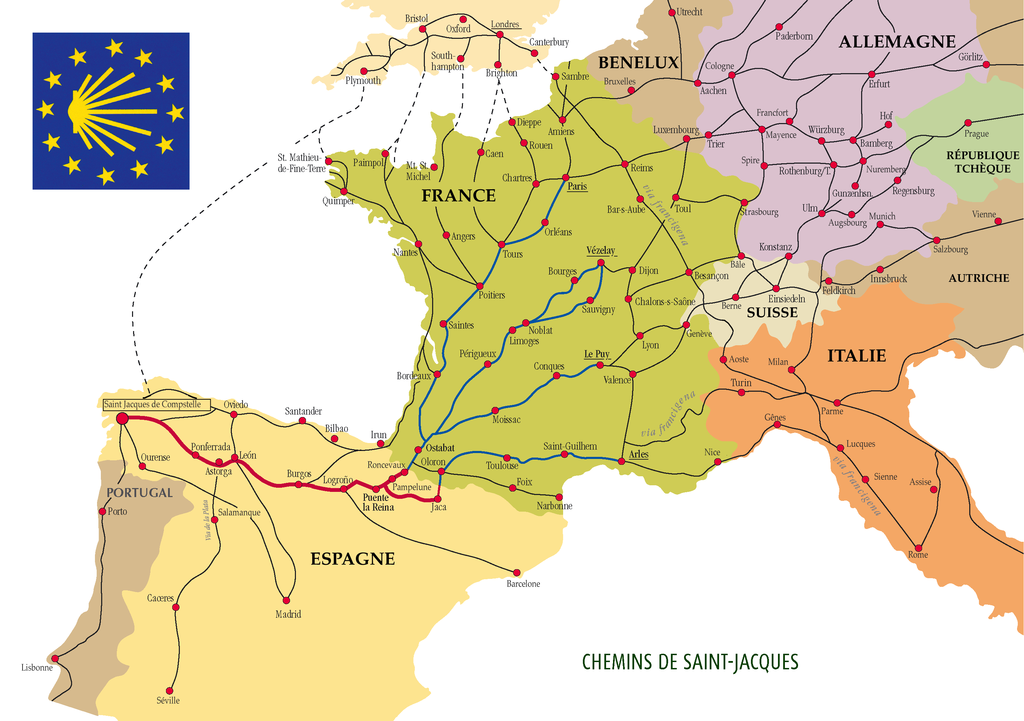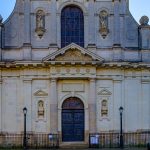Nantes is France’s 6th largest city with some 300,000 inhabitants and 950,000 in the metropolitan area, and it was once the capital of Brittany (that was in the 15th century). Although over the centuries it was part of the Brittany region, nowadays it is no longer considered as such, much to the displeasure of its inhabitants.
The city has received numerous awards for its Quality of Life (including 2004 Time Magazine “The Most Liveable City in Europe” award and the European Green Capital Award in 2013 ).

The city is big, but pretty much flat. It’s not that difficult to walk through the city, but they do have an excellent public transportation system.
The city is named after its first inhabitants, the Gaul tribe known as Namnetes. They established their settlement 2 centuries BC.
One of its most famous citizens is the internationally acclaimed science-fiction writer, Jules Verne (who later move to Amiens, click here to read about his house there).
This city/town forms part of one of the French legs of the Santiago de Compostela pilgrimage route.
Santiago de Compostela pilgrimage routes
The Buildings and Streets
Nantes has a mixture of old and new buildings, mostly due to the extensive Allied bombardements the city endured during the 2nd World War. A lot of the city had to be rebuilt.
 Modern but vintage looking buildings in Nantes
Modern but vintage looking buildings in Nantes Primary school for boys in Nantes
Primary school for boys in Nantes Some of the decorations of buildings in Nantes
Some of the decorations of buildings in Nantes  FNAC store building in Nantes
FNAC store building in Nantes Old facade made out of wood in Nantes
Old facade made out of wood in NantesThe shops in the city are widespread. Almost on any street you will find shops, so it’s not all concentrated in the city centre.
 Colorful shop fronts in Nantes
Colorful shop fronts in Nantes Bakery at night in Nantes
Bakery at night in Nantes Several shops at nightfall in Nantes
Several shops at nightfall in NantesThe streets are safe for walking, ie. you’ll not be bothered that much by speeding cars. There are many pedestrian streets, and car traffic is mostly spread close to the Loire river banks. There are obviously a lot of cars in the city centre, but sidewalks are plenty and traffic is not very fast.
 Small cobblestone street in city centre of Nantes
Small cobblestone street in city centre of Nantes Shopping pedestrian street in Nantes
Shopping pedestrian street in Nantes Nightfall in a pedestrian shopping street in Nantes
Nightfall in a pedestrian shopping street in Nantes Bars and restaurants in pedestrian streets in Nantes
Bars and restaurants in pedestrian streets in Nantes More bars and restaurants in Nantes
More bars and restaurants in NantesThe last photo above is of the famous Irish pub, John McByrne.
The Duke’s Castle
The most famous and well known building in Nantes is the 13th century Duke’s Castle:

This is the former home of the Duke of Brittany, and therefore the ruler of Brittany. It’s a very big castle and can be seen as the centerpoint of Nantes.
Click here to read our review of the castle.
The Cathedral
Very close to the castle you will find another important building in Nantes; the Saint-Pierre-et-Saint-Paul de Nantes Cathedral, dating back to the 15th century.

Click here to read our review of the cathedral.
St. Pierre Gate
Alongside the cathedral you will find a few more old walls and gates which were once upon a time part of the city walls and defenses.
 Part of the old walls and fortifications of Nantes, close to the cathedral
Part of the old walls and fortifications of Nantes, close to the cathedral Old gate (St Pierre gate) in Nantes, close to the cathedral.
Old gate (St Pierre gate) in Nantes, close to the cathedral.The gate, called Porte St. Pierre, dates back to the 15th century, and is built on Roman foundations dating back to the 3rd century.
There are many religious buildings in Nantes, ranging from Catholic churches (the first bishop to have preached here was in the year 290 AD), Mormon, Muslim, Orthodox and Jewish religious buildings.
Here is one notable catholic church;

This is the Saint Croix church, built in the 17th century and adapted in the 19th century. The clock in this building is beautiful and does not come originally from this church.
Click here to read our review of the St Croix church.
LU Tower
Another visible and famous building in Nantes is the LU Tower. LU is the name of a famous French biscuit manufacturer who had its head office here.
 The LU Tower of the (former) biscuit maker in Nantes
The LU Tower of the (former) biscuit maker in Nantes The LU Tower up close in Nantes
The LU Tower up close in Nantes The LU Tower as seen from the castle in Nantes
The LU Tower as seen from the castle in NantesThe factory was built in 1895 and the (then) 2 towers were built in 1909. However, only 1 tower survived the WWII bombings and future municipal works.
Today it’s part of a cultural centre and is called “Le Lieu Unique” (retaining the LU abbreviation). NOTE: The biggest hamman in France is located in this centre.
Today, LU stil have a presence next to their former tower:

The LU logo visible in the photo above was made by the American designed Raymond Loewy.
The Cours Saint-Andre and Saint-Pierre
There is a very long but narrow park close to the cathedral, separated by a roundabout with a very large statue. On the Northern part of the statue, it’s called Cours Saint-Andre, the Southern part is called Cours Saint-Pierre.
The cathedral is located alongside the Saint-Pierre part. Several large and imposing buildings can be found along the way, including the headquarters of the 11th Army Corps of the French Army (which was created in 1870 and had fought in the first and the early stages of second world war). After the start of WWII, it was overrun by Rommel.
 Cours Saint-Pierre in Nantes
Cours Saint-Pierre in Nantes 11th Army Corps former head quarters in Nantes
11th Army Corps former head quarters in Nantes The Oratory Chapel in Nantes
The Oratory Chapel in Nantes Closeup of the Oratory Chapel in Nantes
Closeup of the Oratory Chapel in Nantes The buildings as seen on the Cours Saint-Pierre, in Nantes
The buildings as seen on the Cours Saint-Pierre, in Nantes The Colonne Louis XVI at Place Marechal-Foche in Nantes
The Colonne Louis XVI at Place Marechal-Foche in NantesAt the end of the Cours Saint-Pierre, at the top of the steps you will find several large statues and memorials:
 The ‘Monument aux morts de la guerre de 1870’, in English, the Monument to the dead during the war of 1870
The ‘Monument aux morts de la guerre de 1870’, in English, the Monument to the dead during the war of 1870 The ‘Monument aux morts de la guerre de 1870’ in Nantes
The ‘Monument aux morts de la guerre de 1870’ in Nantes Statue of Arthur III, Duke of Brittany
Statue of Arthur III, Duke of Brittany Statue of Anne of Brittany
Statue of Anne of BrittanyThe Memorial for the dead of the war in 1870 refers to the Franco-Prussian War. The memorial was erected in 1897.
Two of the statues in the photos are of Arthur III, Duke of Brittany (aka Arthur de Richemont) who had fought alongside Joan of Arc and the other statue is of Anne of Brittany, the Duchess of Brittany.
Machines of the Isle of Nantes
One of the biggest tourist attractions of Nantes can be found after crossing the Loire river.

When you cross the river, you arrive at the Island of Nantes. Towards the West of this rather large island you will find the Machines of the Isle of Nanets (in French “Les Machines de l’île”).

This is a special place, which even includes an enormous mechanical (steampunk) elephant. It is the place to wind-down for the citizens of Nantes.
Click here to read our review of the Machines of the Isle of Nantes.
Conclusion
Nantes is a very dynamic and fun place to visit. It’s quite a big place with several universities (which means it’s a very young city), many terraces, bars, cafes, museums, theaters and many beautiful buildings.

You’ll find something for everybody in this city.
Related Posts
- 10000
- 10000
 The building of the cathedral of Nantes, named the Saint-Pierre-et-Saint-Paul de Nantes, started in the 15th century, and like most cathedrals, work lasted for hundreds of years. In this case, the cathedral was officially complete 457 years after it was started. However, this is the 3rd cathedral to be built…
The building of the cathedral of Nantes, named the Saint-Pierre-et-Saint-Paul de Nantes, started in the 15th century, and like most cathedrals, work lasted for hundreds of years. In this case, the cathedral was officially complete 457 years after it was started. However, this is the 3rd cathedral to be built… - 10000
- 10000
- 10000
 Transport Getting there Air: Nantes has a big international airport, and they are building an even bigger one (which is highly controversial). Flights are served throughout Europe and Africa, North America and the Middle East. Click here to access the Nantes airport website Ferry: There are no direct ferry services…
Transport Getting there Air: Nantes has a big international airport, and they are building an even bigger one (which is highly controversial). Flights are served throughout Europe and Africa, North America and the Middle East. Click here to access the Nantes airport website Ferry: There are no direct ferry services…



